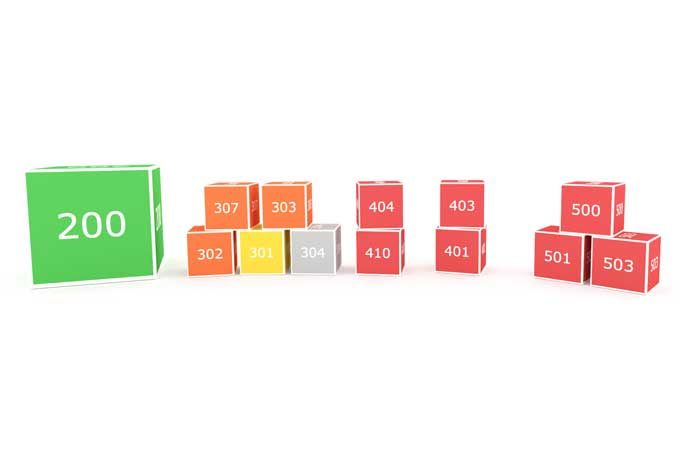When an SEO project comes in, an SEO person ensures the website has no crawling or indexing issues. For this, they get an audit of the website, and in this process, they encounter HTTP status codes quite often. If you are also an SEO person and want to know about HTTP status codes, this blog is for you. This blog introduces the most common HTTP status codes that hugely impact the SEO of a website. A complete understanding of these status codes will help you acknowledge the urgency to resolve them and enhance the performance of websites.
What are HTTP Status Codes?
HTTP status codes are server responses to browsers. You must be wondering, what does that mean? It means when we open a link, our browser sends a request to the website’s server to open that link. The server then responds to that request. Based on these responses, servers send three-digit response codes. These codes with a message are HTTP status codes.
For a layman, let us take an example. Have you ever noticed that while browsing, sometimes a page opens up with a three-digit code and a message like 404 Error: Page Not Found? It is an HTTP status code.
What Is The Importance of HTTP Status Codes For SEO?
These codes are crucial for SEO, as they help a lot.
For example,
- These codes are like a conversation between your browser and the server. By understanding status codes, you will know whether things between the two are good or something is wrong. You can diagnose and fix the HTTP status codes if they are not good.
- You can even use some of these status codes to help search engines and users access your site, like redirection codes. They will tell bots and visitors that a page has moved somewhere else permanently.
HTTP Status Code Classes
HTTP Status Codes are categorized into five classes. Each class is based on responses that have similar meanings.
- Informational HTTP Status Codes (100–199): Informational Status Codes indicate that the request initiated by the browser was received and understood by the server, but it is still processing it.
- Successful HTTP Status Codes (200–299): Successful Status Codes convey that the server has successfully received, understood, and processed the browser’s request and has returned the expected data to the browser.
- Redirection HTTP Status Codes (300–399): These codes inform that the server cannot complete the browser’s request for a page because a new source has replaced the requested resource. Further action is required to complete the request.
- Client HTTP Status Codes (400–499): Client HTTP Status Codes (400–499): Client Error Codes convey some problem with the request, so the server cannot fulfill it.
- Server HTTP Status Codes (500–599): These are server error codes indicating that the request was accepted but that an error on the server prevented the fulfillment of the acceptable request.
Each code has a specific and unique meaning. If you have even a general idea about these classes, you would tell quickly what the matter is with the site. For example, if a web page shows up with 5XX errors, you will know they are server-related errors. If 4XX errors show up, you can tell they are client errors. Once you know the cause of the issue, you can look for solutions.
To cover each code, from 100 to 599, in this blog would make it too long. So, we will cover each class comprehensively in other blogs.
Do all The HTTP Status Codes Badly Affect the SEO of a Website?
A simple answer is NO. Each HTTP status code does not have much impact on SEO. Like, informational and successful HTTP status codes have a minimal effect on the SEO of a website. They convey that everything is okay, as it is supposed to be, and bots can continue their way on the website. However, they do not boost the ranking of a website either.
On the other hand, client and server codes are the red flags that need immediate attention because they highly affect the ranking of websites. They can prevent bots from crawling and indexing your pages. Too many of these errors can make bots believe that the site is not high-quality, which would possibly lower its rankings. Each SEO person and website owner must keep their eye on it because they hugely impact the SEO of a website.
List of the Most Common HTTP Status Codes That Hugely Impact SEO
Now you know what HTTP Status Codes are, so let us dig into the most common HTTP status codes that hugely impact the SEO of a website.
Here is the list:
HTTP Status Code 200: OK
The 200 Status Code is a successful response code that conveys that the webpage is good. Be happy when this code appears because it reveals that everything about the web page is as perfect as it should be. We must aim to get this status code for all the web pages of a website.
HTTP Status Code 301: Moved Permanently
The 301 Status Code is one of the redirection status codes. It conveys essential information to users and search engines. It implies that the content of a web page has been permanently moved to another location and that the original URL is no longer available.
When should we use 301 redirections?
We must use 301 redirections when we
- Edit a URL
- Delete a web page
- Change the domain names
HTTP Status Code 302: Moved Temporarily
The 302 Status Code is also one of the redirection status codes. It conveys that the URL is temporarily redirected to another location or URL.
When should we use 302 redirections?
We must use 302 redirections when we have to shut down a web page for some reason, but you do not want to show a 404 error. In this case, we can use 302 redirects. It will direct our visits to another location, like the home page or other similar web pages.
Difference Between 301 and 302 Redirections:
Both are redirection status codes that redirect users and search engines from one URL to another. However, they are different in terms of carrying forward the SEO advantage. When we build links for a web page, we get link equity, also known as link juice. It is the link value and authority we get from the web page on which we build backlinks. When we use permanent redirection (301), it moves the link equity of the old URL to the new one. However, a temporary redirection (302) does not do that. They do not shift the SEO advantage of all the link-building you have done on the URL. In fact, we must not use 301 redirections when we know that we will remove it and use the original URL.
HTTP Status Code 404: Not Found
The 404 is a red flag kind of status code. We can put it under HTTP Error Codes. When this error message comes up, we must resolve them as soon as possible. This error message shows up when we try to find a web page on a server, but it does not access it. It could be because the web page we are looking for does not exist or the URL we typed has some errors.
Why Should We Fix 404 Error Codes As Soon As Possible?
When a visitor lands on dead-end 404 errors, they will be disappointed and shut the web page. And, they will possibly visit the links of our competitor. It signals search engines that the content on the web page is not adding value to a particular keyword query. As a result, they drive the ranking of the webpage down.
The 404 errors also stop crawlers from crawling a website, and it is the worst thing that affects the ranking of a website.
Therefore, we must fix HTTP error codes as early as possible.
HTTP Status Code 500: Internal Server Error
This status code is also an error code that indicates a problem with the internal or website’s server.
Why Should We Fix 500 Internal Server Errors As Soon As Possible?
The 500 internal server errors harm the SEO of a website if it occurs frequently. This internal server error affects the accessibility of a website; visitors and search engine bots will not be able to access it. This error could signal to search engines that they should not try to crawl those pages because search engines prefer well-maintained sites with no errors. It could drop a page from the search engine index. Hence, it would be best to investigate and resolve internal server errors as soon as you encounter them.
Conclusion
We hope this blog has helped you understand HTTP status codes. If you are working on the SEO of a website, you need to get some awareness about them. They will help you fix errors in the website and enhance its performance. These codes are very informative and impactful for maintaining a website. Here, we have only covered the most common HTTP status codes that hugely affect the SEO of a website that will help you troubleshoot and resolve the errors.










